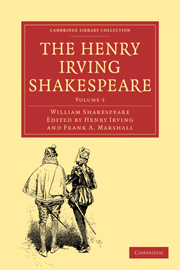5 - MACBETH
Published online by Cambridge University Press: 29 August 2010
Summary
INTRODUCTION
LITERARY HISTORY
Macbeth was first printed in the Folio of 1623, and the printing seems to have been done with singular carelessness, or from a singularly imperfect MS., probably a hastily-made transcript. All that we know with certainty of the date when the play was written, is, that it was some time before 1610. In Collier's New Particulars regarding the Works of Shakespeare, 1836, there is an account of a MS. discovered in the Ashmolean Museum, containing the “Booke of Plaies and Notes thereof” of Dr. Simon Forman, the notorious astrologer, who died in 1611. The entry for April 20, 1610, is given by Collier as follows:
“In Macbeth, at the Globe, 1610, the 20th of April, Saturday, there was to be observed, first how Macbeth and Banquo, two noblemen of Scotland, riding through a wood, there stood before them three women Fairies, or Nymphs, and saluted Macbeth, saying three times unto him, Hail, King of Codor, for thou shalt be a King, but shalt beget no Kings, &c. Then, said Banquo, What all to Macbeth and nothing to me? Yes, said the Nymphs; thou shalt beget Kings, yet be no King. And so they departed, and came to the Court of Scotland to Duncan King of Scots, and it was in the days of Edward the Confessor. And Duncan bad them both kindly welcome, and made Macbeth forthwith Prince of Northumberland; and sent him to his own Castle, and appointed Macbeth to provide for him, for he would sup with him the next day at night, and did so.
- Type
- Chapter
- Information
- The Henry Irving Shakespeare , pp. 343 - 430Publisher: Cambridge University PressPrint publication year: 2009First published in: 1889



